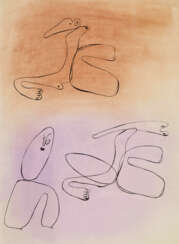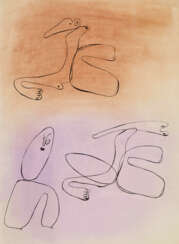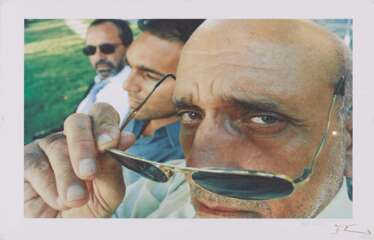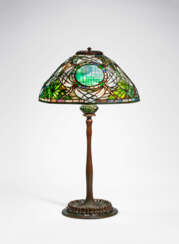jr (1983)

JR (French: Jean René) is the pseudonym of a French photographer and artist who does not give his full name. He lives and works in Paris and New York.
He describes himself as a "photograffeur" (photographer and graffiti artist in one word) and claims that the street is "the biggest gallery in the world". His work is flyposting large black and white images in public spaces. JR works at the intersection of photography, street art, filmmaking and social activism. Over the past two decades he has developed many public projects in cities around the world, from buildings in the slums of Paris to walls in the Middle East and Africa or favelas in Brazil.
JR places large-scale photographic images in public spaces. He started creating graffiti as a teenager on the streets and rooftops of Paris and on the subway. In 2007, he gained worldwide attention by placing huge photographs of Israelis and Palestinians face to face in eight Palestinian and Israeli cities on both sides of the separation barrier. In his works, the photographer always addresses current political and social issues in the world. For example, in 2019, JR worked with a group of inmates of a maximum security prison in California and created a large format piece with portraits of the inmates.
JR has traveled to many cities with his work, participating in exhibitions, he has collaborated with magazines and created films about his work. JR has also directed three feature-length documentaries, one of which, Women Are Heroes (2011) was nominated for an Oscar. At the 2017 Cannes Film Festival, he won the Golden Eye for Best Documentary.


JR (French: Jean René) is the pseudonym of a French photographer and artist who does not give his full name. He lives and works in Paris and New York.
He describes himself as a "photograffeur" (photographer and graffiti artist in one word) and claims that the street is "the biggest gallery in the world". His work is flyposting large black and white images in public spaces. JR works at the intersection of photography, street art, filmmaking and social activism. Over the past two decades he has developed many public projects in cities around the world, from buildings in the slums of Paris to walls in the Middle East and Africa or favelas in Brazil.
JR places large-scale photographic images in public spaces. He started creating graffiti as a teenager on the streets and rooftops of Paris and on the subway. In 2007, he gained worldwide attention by placing huge photographs of Israelis and Palestinians face to face in eight Palestinian and Israeli cities on both sides of the separation barrier. In his works, the photographer always addresses current political and social issues in the world. For example, in 2019, JR worked with a group of inmates of a maximum security prison in California and created a large format piece with portraits of the inmates.
JR has traveled to many cities with his work, participating in exhibitions, he has collaborated with magazines and created films about his work. JR has also directed three feature-length documentaries, one of which, Women Are Heroes (2011) was nominated for an Oscar. At the 2017 Cannes Film Festival, he won the Golden Eye for Best Documentary.


JR (French: Jean René) is the pseudonym of a French photographer and artist who does not give his full name. He lives and works in Paris and New York.
He describes himself as a "photograffeur" (photographer and graffiti artist in one word) and claims that the street is "the biggest gallery in the world". His work is flyposting large black and white images in public spaces. JR works at the intersection of photography, street art, filmmaking and social activism. Over the past two decades he has developed many public projects in cities around the world, from buildings in the slums of Paris to walls in the Middle East and Africa or favelas in Brazil.
JR places large-scale photographic images in public spaces. He started creating graffiti as a teenager on the streets and rooftops of Paris and on the subway. In 2007, he gained worldwide attention by placing huge photographs of Israelis and Palestinians face to face in eight Palestinian and Israeli cities on both sides of the separation barrier. In his works, the photographer always addresses current political and social issues in the world. For example, in 2019, JR worked with a group of inmates of a maximum security prison in California and created a large format piece with portraits of the inmates.
JR has traveled to many cities with his work, participating in exhibitions, he has collaborated with magazines and created films about his work. JR has also directed three feature-length documentaries, one of which, Women Are Heroes (2011) was nominated for an Oscar. At the 2017 Cannes Film Festival, he won the Golden Eye for Best Documentary.


JR (French: Jean René) is the pseudonym of a French photographer and artist who does not give his full name. He lives and works in Paris and New York.
He describes himself as a "photograffeur" (photographer and graffiti artist in one word) and claims that the street is "the biggest gallery in the world". His work is flyposting large black and white images in public spaces. JR works at the intersection of photography, street art, filmmaking and social activism. Over the past two decades he has developed many public projects in cities around the world, from buildings in the slums of Paris to walls in the Middle East and Africa or favelas in Brazil.
JR places large-scale photographic images in public spaces. He started creating graffiti as a teenager on the streets and rooftops of Paris and on the subway. In 2007, he gained worldwide attention by placing huge photographs of Israelis and Palestinians face to face in eight Palestinian and Israeli cities on both sides of the separation barrier. In his works, the photographer always addresses current political and social issues in the world. For example, in 2019, JR worked with a group of inmates of a maximum security prison in California and created a large format piece with portraits of the inmates.
JR has traveled to many cities with his work, participating in exhibitions, he has collaborated with magazines and created films about his work. JR has also directed three feature-length documentaries, one of which, Women Are Heroes (2011) was nominated for an Oscar. At the 2017 Cannes Film Festival, he won the Golden Eye for Best Documentary.


JR (French: Jean René) is the pseudonym of a French photographer and artist who does not give his full name. He lives and works in Paris and New York.
He describes himself as a "photograffeur" (photographer and graffiti artist in one word) and claims that the street is "the biggest gallery in the world". His work is flyposting large black and white images in public spaces. JR works at the intersection of photography, street art, filmmaking and social activism. Over the past two decades he has developed many public projects in cities around the world, from buildings in the slums of Paris to walls in the Middle East and Africa or favelas in Brazil.
JR places large-scale photographic images in public spaces. He started creating graffiti as a teenager on the streets and rooftops of Paris and on the subway. In 2007, he gained worldwide attention by placing huge photographs of Israelis and Palestinians face to face in eight Palestinian and Israeli cities on both sides of the separation barrier. In his works, the photographer always addresses current political and social issues in the world. For example, in 2019, JR worked with a group of inmates of a maximum security prison in California and created a large format piece with portraits of the inmates.
JR has traveled to many cities with his work, participating in exhibitions, he has collaborated with magazines and created films about his work. JR has also directed three feature-length documentaries, one of which, Women Are Heroes (2011) was nominated for an Oscar. At the 2017 Cannes Film Festival, he won the Golden Eye for Best Documentary.
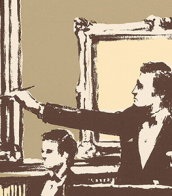

JR (French: Jean René) is the pseudonym of a French photographer and artist who does not give his full name. He lives and works in Paris and New York.
He describes himself as a "photograffeur" (photographer and graffiti artist in one word) and claims that the street is "the biggest gallery in the world". His work is flyposting large black and white images in public spaces. JR works at the intersection of photography, street art, filmmaking and social activism. Over the past two decades he has developed many public projects in cities around the world, from buildings in the slums of Paris to walls in the Middle East and Africa or favelas in Brazil.
JR places large-scale photographic images in public spaces. He started creating graffiti as a teenager on the streets and rooftops of Paris and on the subway. In 2007, he gained worldwide attention by placing huge photographs of Israelis and Palestinians face to face in eight Palestinian and Israeli cities on both sides of the separation barrier. In his works, the photographer always addresses current political and social issues in the world. For example, in 2019, JR worked with a group of inmates of a maximum security prison in California and created a large format piece with portraits of the inmates.
JR has traveled to many cities with his work, participating in exhibitions, he has collaborated with magazines and created films about his work. JR has also directed three feature-length documentaries, one of which, Women Are Heroes (2011) was nominated for an Oscar. At the 2017 Cannes Film Festival, he won the Golden Eye for Best Documentary.


JR (French: Jean René) is the pseudonym of a French photographer and artist who does not give his full name. He lives and works in Paris and New York.
He describes himself as a "photograffeur" (photographer and graffiti artist in one word) and claims that the street is "the biggest gallery in the world". His work is flyposting large black and white images in public spaces. JR works at the intersection of photography, street art, filmmaking and social activism. Over the past two decades he has developed many public projects in cities around the world, from buildings in the slums of Paris to walls in the Middle East and Africa or favelas in Brazil.
JR places large-scale photographic images in public spaces. He started creating graffiti as a teenager on the streets and rooftops of Paris and on the subway. In 2007, he gained worldwide attention by placing huge photographs of Israelis and Palestinians face to face in eight Palestinian and Israeli cities on both sides of the separation barrier. In his works, the photographer always addresses current political and social issues in the world. For example, in 2019, JR worked with a group of inmates of a maximum security prison in California and created a large format piece with portraits of the inmates.
JR has traveled to many cities with his work, participating in exhibitions, he has collaborated with magazines and created films about his work. JR has also directed three feature-length documentaries, one of which, Women Are Heroes (2011) was nominated for an Oscar. At the 2017 Cannes Film Festival, he won the Golden Eye for Best Documentary.


Joan Miró, a celebrated Spanish artist, was a master in painting, sculpture, and ceramics, renowned for his unique style that blurred the lines between Surrealism, Fauvism, and Expressionism. Born in Barcelona to a family of a goldsmith and a watchmaker, Miró grew up immersed in the rich cultural heritage of the Barri Gòtic neighborhood. His artistic journey began with drawing classes at the age of seven and continued at the prestigious La Llotja art academy. Despite an initial venture into the business world, Miró's passion for art prevailed, leading him to abandon his clerical career after a nervous breakdown.
Miró's work is noted for its exploration of the subconscious, often depicting a childlike perspective. This approach was both a critique of traditional painting methods and a means of expressing Catalan pride. His art, challenging to categorize, often featured symbolic elements and nationalistic qualities. One of his notable early works, "The Farm," reflects a transition to a more individual style, blending elements of his Catalan roots with broader artistic influences. This piece, later purchased by Ernest Hemingway, encapsulated the essence of Spain in its imagery.
In Paris, Miró joined the Surrealist movement in 1924, where his work began to reflect the influence of automatism, emphasizing spontaneous, automatic, or subconscious creation. He experimented with various mediums, including painting-poetry and collage, and even ventured into set and costume design for Sergei Diaghilev's Ballets Russes.
During World War II, Miró remained in Spain, and his work from this period, including the 22 Constellations series, reflected an interest in the night, music, and stars. His forms became increasingly abstracted, and he experimented with various techniques, often incorporating primary colors and evocative titles.
Miró's career spanned several decades, during which he continually evolved his style and explored new mediums. His contributions to art were recognized with numerous awards and retrospectives, including a major career retrospective at MoMA in 1941 and the Spanish Gold Medal for Fine Arts in 1980. Among his last major works was a tapestry for the World Trade Center in New York City, created in 1974.
For art collectors and enthusiasts, Joan Miró remains a figure of immense interest, not only for his distinct style and contributions to Surrealism but also for his ability to blend poetic imagery with political commentary. To stay updated on new product sales and auction events related to Joan Miró, sign up for our updates and immerse yourself in the world of this extraordinary artist.


Joan Miró, a celebrated Spanish artist, was a master in painting, sculpture, and ceramics, renowned for his unique style that blurred the lines between Surrealism, Fauvism, and Expressionism. Born in Barcelona to a family of a goldsmith and a watchmaker, Miró grew up immersed in the rich cultural heritage of the Barri Gòtic neighborhood. His artistic journey began with drawing classes at the age of seven and continued at the prestigious La Llotja art academy. Despite an initial venture into the business world, Miró's passion for art prevailed, leading him to abandon his clerical career after a nervous breakdown.
Miró's work is noted for its exploration of the subconscious, often depicting a childlike perspective. This approach was both a critique of traditional painting methods and a means of expressing Catalan pride. His art, challenging to categorize, often featured symbolic elements and nationalistic qualities. One of his notable early works, "The Farm," reflects a transition to a more individual style, blending elements of his Catalan roots with broader artistic influences. This piece, later purchased by Ernest Hemingway, encapsulated the essence of Spain in its imagery.
In Paris, Miró joined the Surrealist movement in 1924, where his work began to reflect the influence of automatism, emphasizing spontaneous, automatic, or subconscious creation. He experimented with various mediums, including painting-poetry and collage, and even ventured into set and costume design for Sergei Diaghilev's Ballets Russes.
During World War II, Miró remained in Spain, and his work from this period, including the 22 Constellations series, reflected an interest in the night, music, and stars. His forms became increasingly abstracted, and he experimented with various techniques, often incorporating primary colors and evocative titles.
Miró's career spanned several decades, during which he continually evolved his style and explored new mediums. His contributions to art were recognized with numerous awards and retrospectives, including a major career retrospective at MoMA in 1941 and the Spanish Gold Medal for Fine Arts in 1980. Among his last major works was a tapestry for the World Trade Center in New York City, created in 1974.
For art collectors and enthusiasts, Joan Miró remains a figure of immense interest, not only for his distinct style and contributions to Surrealism but also for his ability to blend poetic imagery with political commentary. To stay updated on new product sales and auction events related to Joan Miró, sign up for our updates and immerse yourself in the world of this extraordinary artist.




Lucian Michael Freud was a British painter and draughtsman, specialising in figurative art, and is known as one of the foremost 20th-century English portraitists. He was born in Berlin, the son of Jewish architect Ernst L. Freud and the grandson of Sigmund Freud. Freud got his first name "Lucian" from his mother in memory of the ancient writer Lucian of Samosata. His family moved to England in 1933 to escape the rise of Nazism. From 1942 to 1943 he attended Goldsmiths College, London. He served at sea with the British Merchant Navy during the Second World War.



Pablo Ruiz Picasso, a Spanish artist renowned for his revolutionary contributions to the 20th-century art scene, is a figure that resonates profoundly with collectors and art experts. His unique blend of talents in painting, sculpture, printmaking, and ceramic art, infused with his time in France, positioned him as a pivotal character in modern art history.
Picasso's artistic journey was marked by distinct periods, each showcasing his evolving style and genius. His early years were characterized by the Blue Period (1901-1904), followed by the Rose Period (1904-1906), and then the African-influenced Period (1907-1909). Picasso's name is synonymous with Cubism, a movement he co-founded, which significantly altered artistic perspectives and methods. Works like "Les Demoiselles d'Avignon" (1907) and "Guernica" (1937) are emblematic of his cubist legacy, the latter being a poignant anti-war statement that remains influential.
His later years saw a return to more traditional styles, with neoclassical and surrealist influences becoming evident. Works from these phases reflect a deep engagement with mythological themes, as seen in "Faun with Stars" (1955), symbolizing his late-life romance with Jacqueline Roque, his second wife.
Picasso's prolific output and innovative spirit made him a legend in his own time, a status that only grew after his death. His works, housed in major museums and private collections worldwide, continue to captivate and inspire.
As a collector or expert in art and antiques, staying informed about Picasso's works, their auction events, and sales is essential. To stay updated on the latest developments and opportunities related to Pablo Picasso, sign up for our specialized updates. Rest assured, this subscription will focus solely on new product sales and auction events pertaining to Picasso's art, ensuring that you receive only the most relevant and valuable information.


John Frederick Peto was an American trompe-l'œil ("fool the eye") painter who was long forgotten until his paintings were rediscovered along with those of fellow trompe-l'œil artist William Harnett.


Edward Hopper was an American painter renowned for his skill in depicting the solitude of modern life with evocative uses of light and shadow. Born in 1882 in Nyack, New York, Hopper's early exposure to art came from his supportive parents who nurtured his talents. He began formal art studies at the New York School of Art, learning under influential teachers like William Merritt Chase and Robert Henri. Henri, in particular, encouraged his students to paint personal significance into their works.
Hopper’s style, characterized by its emphasis on solitude and the mundane aspects of American life, often featured settings such as diners, gas stations, and apartment interiors. One of his most famous works, Nighthawks, depicts patrons sitting in a brightly lit diner at night, each seemingly lost in their own thoughts—a perfect example of his theme of urban isolation.
Throughout his career, Hopper enjoyed considerable success and influence, culminating in several retrospectives, including a prominent one at the Museum of Modern Art. His approach to depicting light and his stark, realist views on everyday scenes influenced generations of artists and continue to captivate audiences today. His works are pivotal in understanding American realism and are held in high esteem in museums across the United States.
Lastly, for art collectors and enthusiasts keen on updates about exhibitions or sales featuring Edward Hopper's art, consider signing up for relevant newsletters or alerts. This ensures you remain informed about opportunities to appreciate or acquire works by this pivotal American artist.


Maurice Brazil Prendergast was an American post-Impressionist painter known for the vibrant and saturated colors he used in his work, mostly in the genre of landscape and urban life. In 1886 Prendergast moved to Paris, where he studied at the École Julien under the tutelage of the masters of Impressionism, including Paul Cézanne, who had a great influence on Prendergast's style.
After his return to the United States in 1891, Prendergast became a popularizer of Impressionism in the United States. His work became brighter and more saturated in color than other American artists of the time, and he began to use a dotted style similar to the technique of divisionism. His paintings became similar to tapestries or mosaics.
Prendergast became a member of a group of artists known as the Founders of American Art, who advocated the use of bright and saturated colors instead of the muted and earthy tones adopted in traditional American art. Prendergast left behind a legacy that laid the foundation for the development of Post-Impressionism and Modernism in American art.


Rembrandt Harmenszoon van Rijn, a Dutch Baroque painter and printmaker, was born on July 15, 1606, in Leiden, Netherlands, and died on October 4, 1669, in Amsterdam. He is celebrated as one of the greatest storytellers in art history, acclaimed for his adept portrayal of human emotions and dramatic narratives. Rembrandt's extensive oeuvre includes portraits, self-portraits, landscapes, genre scenes, allegorical, historical, and biblical themes, as well as animal studies. His artistry shined during the Dutch Golden Age, a period marked by cultural and scientific achievements in the Netherlands.
Rembrandt's education in art began around the age of 10 when he left the Latin School in Leiden to train as an artist. He apprenticed with artists like Jacob van Swanenburg and Pieter Lastman, mastering various aspects of painting. He opened his own studio in Leiden around 1624 or 1625, sharing it with his colleague Jan Lievens. By 1631, he had moved to Amsterdam, where he achieved significant success and trained many important Dutch painters.
Among Rembrandt's notable works are "The Anatomy Lesson of Dr. Nicolaes Tulp" (1632), "The Night Watch" (1642), and "The Syndics of the Amsterdam Drapers’ Guild" (1662). He was also renowned for his self-portraits, creating around 80 over his lifetime, more than any other artist until the 20th century. These self-portraits were not just artistic endeavors but also experiments with facial expressions and lighting effects. Additionally, Rembrandt was a master etcher, transforming etching from a reproductive technique into an art form.
Rembrandt's painting style is characterized by its dramatic use of light and shadow, known as chiaroscuro. His ability to depict materials realistically was unparalleled; his portrayal of metals and fabrics was so lifelike that they appeared to glow and be tangible. He was also known for his impasto technique, applying paint thickly to the canvas, adding a three-dimensional quality to his works.
Despite his artistic prowess, Rembrandt faced financial difficulties and personal tragedies throughout his life. He declared bankruptcy in 1656, a downfall attributed partly to his extensive collection of art objects and curiosities. His masterpieces, however, continued to garner appreciation and influence generations of artists that followed.
For collectors and experts in art and antiques, Rembrandt's works represent a pinnacle of artistic achievement in the Dutch Golden Age. His mastery in portraying the human condition and his innovative techniques in painting and etching make his works highly prized and influential in the art world.
To stay updated on new product sales and auction events related to Rembrandt van Rijn, sign up for our updates. This subscription service is dedicated exclusively to news and events concerning works related to this unparalleled master of the Dutch Golden Age.















